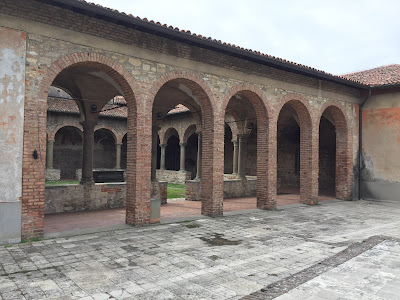

Left: Cymbalaria muralis (Pennywort) on a wall. Right: A wall in the third cloister of Convento di San Francesco (Bergamo) where pennywort grows. The wall looks north.
To say this plant is ubiquitous is an understatement. It’s one of the first plants I noticed when we landed in Bergamo over a year ago. Today, I'm at the ex-Convento di San Francesco. It's a warm Sunday morning and I'm staring at this plant and its dainty flowers again. It's about time to find out what the plant is called and why it is so ubiquitous.
The plant is called Cymbalaria muralis, and it is native to south and southwest Europe. Some references place C. muralis in the plantain family (Plantaginaceae) and others in the figwort family (Scrophulariaceae). The little labiate flowers, usually rose to violet colored, add a happy accent to any wall.
C. muralis has a number of suggestive common names as detailed on the U.S. National Plant Germplasm Site: coliseum-ivy, ivy-leaf-toadflax, mother-of-thousands, Oxford-ivy, pennywort, wandering-sailor, and others. I personally like pennywort. In Italian, it is commonly called ciombolino comune.
The success of pennywort, according to Plant Tropisms: And other Growth Movements (J.W. Hart, p. 101), it due to its curious behavior in respect to light, or phototropism. “After fertilization the previously phototropic stalk bends away from the light to the extent that the ripening seed pod becomes buried in some dark crevice…” That goes a ways toward explaining pennywort's ubiquity.
The Convento di San Francesco dates back to the 13th century and is located in Bergamo’s upper city, Città Alta. I wonder what the friars 700 years ago called this plant?


Left: The third cloister at Convento di San Francesco, looking into second cloister called the Chiostro del Pozzo. Right: View of the main cloister, Chiostro dell Arche.
No comments:
Post a Comment
All comments are moderated. If your comment doesn't appear right away, it was likely accepted. Check back in a day if you asked a question.